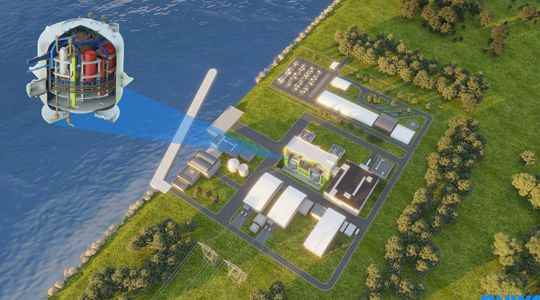In a long-term industry like the nuclear industry, subject to mountains of procedures and authorizations given by the competent organizations, it is often difficult to distinguish the decisive advances. EDF nevertheless believes this Thursday, June 2, to have reached a very important milestone for the development of its small modular Nuward reactor. In a press release published in the morning, the electrician announced that it had jointly contacted three European nuclear safety authorities – in France, the Czech Republic and Finland – for a review of the safety characteristics of its miniature nuclear reactor.
Nuward is the project developed since 2019 by the public group, in partnership with Naval Group, TechnicAtome and the CEA. While the expansion of nuclear power has so far been fueled above all by the development of high-power reactors – France is still banking on this with its project to build six EPRs – many experts are convinced that there will be room tomorrow for reactors of more modest size. For example, the Nuward project plans to combine two 170 MW reactors in a very compact plant, compared to almost ten times more for the EPR2. “SMRs can replace old coal-fired power plants of equivalent power, those using fuel oil, oil or gas or supply means of hydrogen production”, explains Renaud Crassous, SMR project director at EDF.
In January in Belfort, Emmanuel Macron announced an investment of 500 million for the development of this reactor. One way for France not to fall too far behind competitors, when everyone expects to have put the package on technology by 2030. The United States, with NuScale and the BWRX-300 of the American-Japanese alliance GE-Hitachi, is ahead in the Western world, closely followed by the British SMR from Rolls-Royce and the French Nuward. Outside the Western camp, China is also advancing very quickly, as is Russia, which has installed a reactor of this type in Siberia, but which is in fact very largely inspired by those used for its nuclear submarines, says Renaud. Crassus. All hoping to be there by 2030 with a first “head of series” type model or a first model under construction. The playing field could be enormous. “The International Energy Agency, in its 1.5° scenarios, estimates that the share of nuclear could increase from 400 to 800 GW by 2050. Even assuming that you only have 10% of these 400 GW additional in SMR, that gives you almost a hundred small reactors in the world. There will be room for several models”, wants to believe the expert.
Share the approach
Still, to be there, the process of examination and certification of the reactors in terms of safety by the competent authorities is also necessary. EDF has understood this well. By simultaneously approaching the French, Finnish and Czech safety authorities, the electrician seeks to pool its approach, save time and prepare the ground before future industrial milestones. “This collaboration will help (…) improve Nuward’s ability to anticipate international licensing challenges and meet future market needs,” the group said in a statement.
“This is a very significant step and to date unprecedented, says Renaud Crassous. The ambition with the SMR is to be the benchmark player at European level. To produce dozens of them from 2050 to have a serial effect and lower costs. We want to be sure to develop a standard that is acceptable to several countries at the same time, and not to multiply the variants because of divergent expectations from safety authorities.”
The choice of authorities consulted is obviously not trivial either. France could choose in the coming years to complete its fleet of large reactors with these miniature models. The Czech Republic is even more advanced, having already launched several declarations of intent with NuScale, GE-Hitachi, Rolls-Royce and even EDF. As for Finland, it is considering these same SMRs in some of its cities for the replacement of district heating. “There is obviously a logic of opportunity, we are not going to countries that are not interested. Other countries will eventually be able to join this unprecedented consultation process”, judges the EDF manager.
Putting yourself in the small papers of the European nuclear safety authorities, enough to outdo Nuward’s opponents and become the leader of the SMR in Europe? “With this approach, we necessarily project ourselves beyond the first copy, we are convinced that it is a guarantee of strong differentiation to win multiple export projects”, concludes Renaud Crassous. It will also be necessary to be effective on industrial guarantees and competitiveness. Finally, and as always with nuclear power, French economic diplomacy will have to be there.
